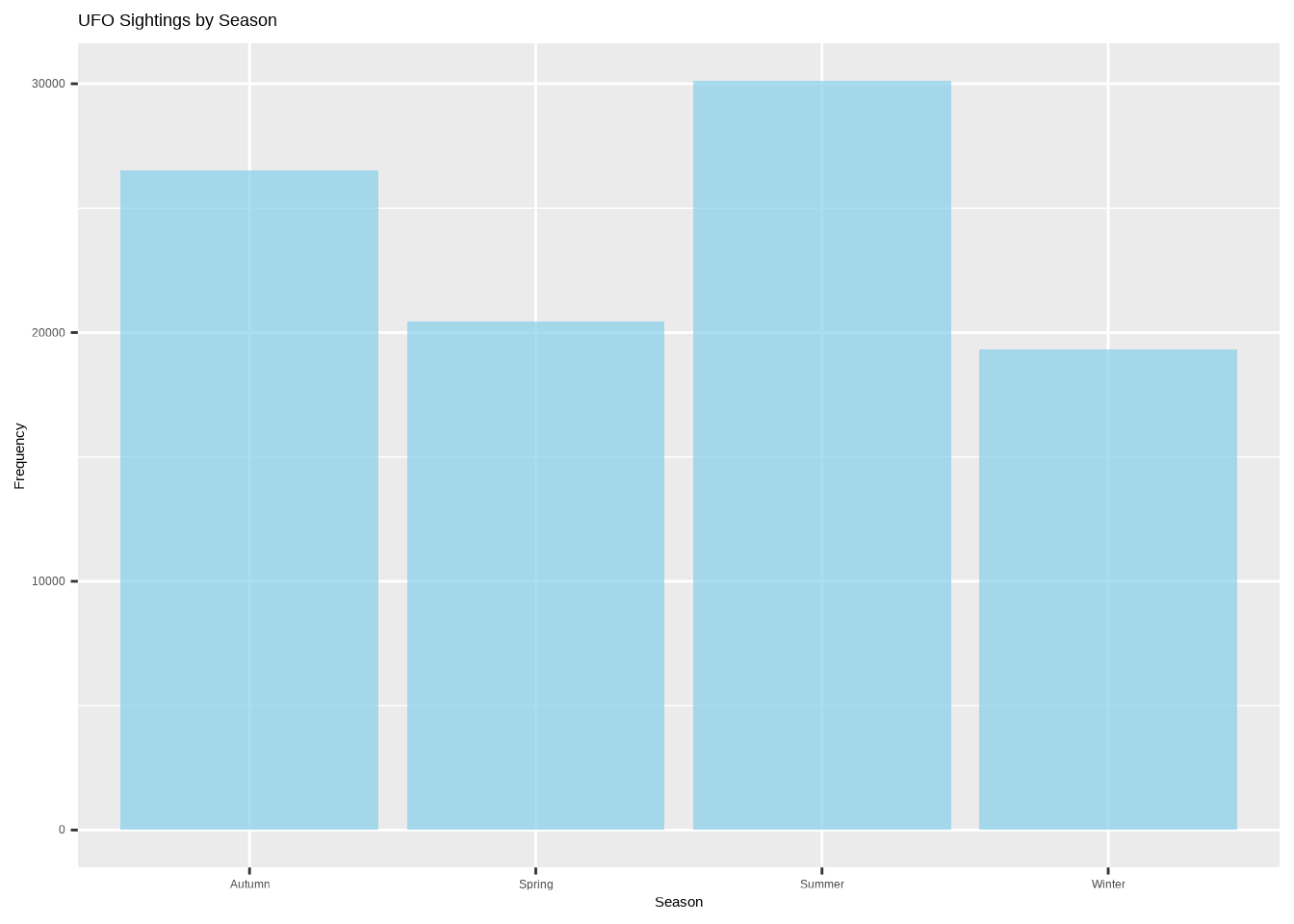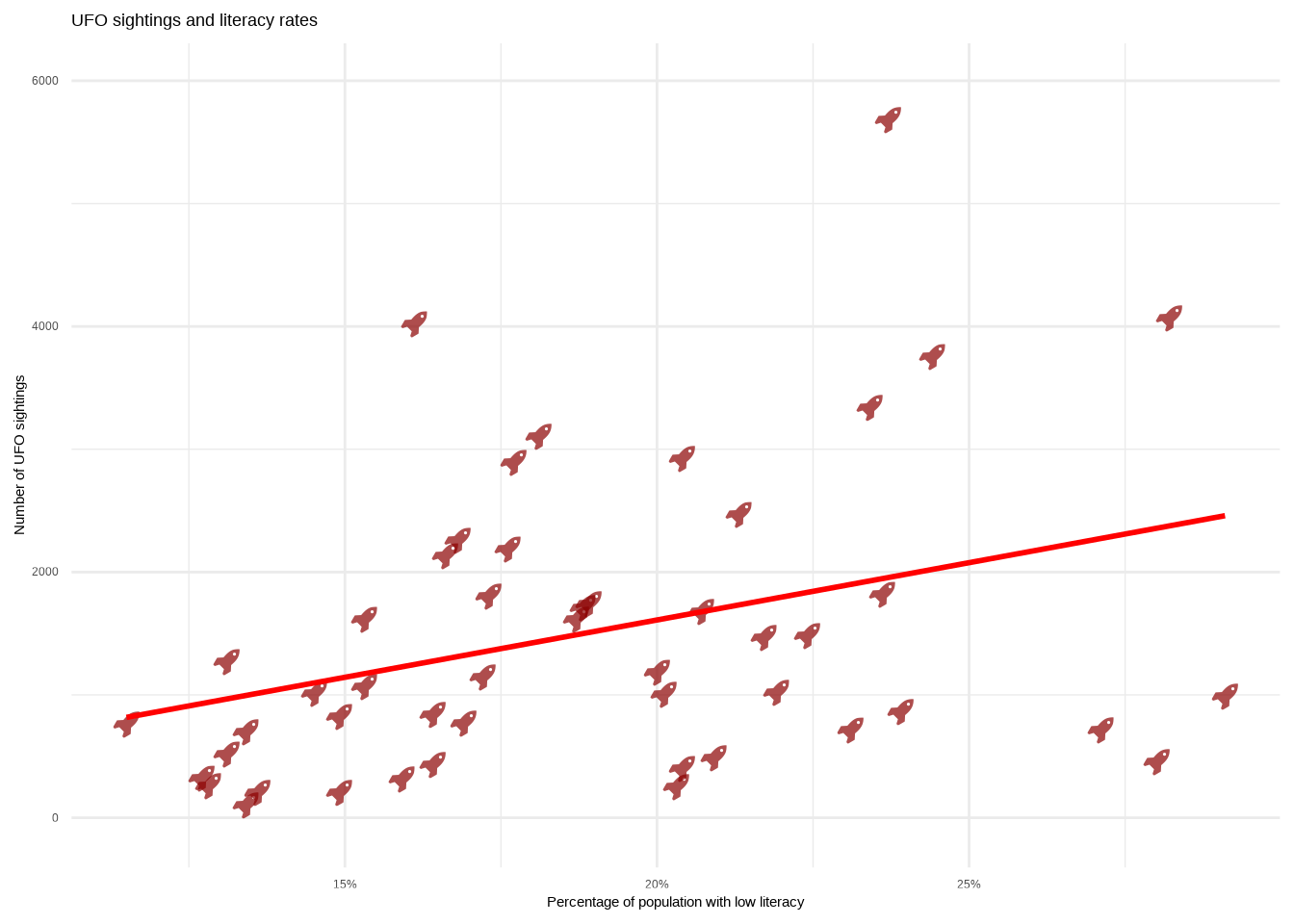── Attaching core tidyverse packages ──────────────────────── tidyverse 2.0.0 ──
✔ dplyr 1.1.4 ✔ readr 2.1.5
✔ forcats 1.0.0 ✔ stringr 1.5.1
✔ ggplot2 3.4.4 ✔ tibble 3.2.1
✔ lubridate 1.9.3 ✔ tidyr 1.3.0
✔ purrr 1.0.2
── Conflicts ────────────────────────────────────────── tidyverse_conflicts() ──
✖ dplyr::filter() masks stats::filter()
✖ dplyr::lag() masks stats::lag()
ℹ Use the conflicted package (<http://conflicted.r-lib.org/>) to force all conflicts to become errors
Attaching package: 'scales'
The following object is masked from 'package:purrr':
discard
The following object is masked from 'package:readr':
col_factor
Attaching package: 'janitor'
The following objects are masked from 'package:stats':
chisq.test, fisher.test
Attaching package: 'gridExtra'
The following object is masked from 'package:dplyr':
combineUFO Sighting Patterns Across Education, Politics, and Time
Rows: 96429 Columns: 12
── Column specification ────────────────────────────────────────────────────────
Delimiter: ","
chr (7): city, state, country_code, shape, reported_duration, summary, day_...
dbl (1): duration_seconds
lgl (1): has_images
dttm (2): reported_date_time, reported_date_time_utc
date (1): posted_date
ℹ Use `spec()` to retrieve the full column specification for this data.
ℹ Specify the column types or set `show_col_types = FALSE` to quiet this message.
Rows: 14417 Columns: 10
── Column specification ────────────────────────────────────────────────────────
Delimiter: ","
chr (6): city, alternate_city_names, state, country, country_code, timezone
dbl (4): latitude, longitude, population, elevation_m
ℹ Use `spec()` to retrieve the full column specification for this data.
ℹ Specify the column types or set `show_col_types = FALSE` to quiet this message.
Rows: 26409 Columns: 12
── Column specification ────────────────────────────────────────────────────────
Delimiter: ","
dbl (2): rounded_lat, rounded_long
date (1): rounded_date
time (9): astronomical_twilight_begin, nautical_twilight_begin, civil_twilig...
ℹ Use `spec()` to retrieve the full column specification for this data.
ℹ Specify the column types or set `show_col_types = FALSE` to quiet this message.Introduction
TidyTuesday’s UFO sightings dataset:
The dataset is a culmination of 3 CSV files
ufo_sightings.csv- This csv file gives information about when, where, how, and important information pertinent to the sighting itself
places.csv- Gives additional information about the place itself
day_parts_map.csv- Gives information about the sunrise, sunset, and astronomy information about the day in particular
Seasonal Frequency of UFO Sighting over the years.
Introduction
Question: During what part of year is UFO sighting more frequent and how does these trends change over the years? By categorizing these sightings into seasons—Spring, Summer, Autumn, and Winter—we can explore whether certain times of the year are more prone to such phenomena. `posted_date, which are the posted date of UFO sightings, will be used to answer the question.
Approach
To analyze the temporal distribution of UFO sightings, two distinct types of plots will be employed: a bar plot and a line plot. The bar plot will be utilized to represent the frequency of sightings across different seasons, offering a clear visual comparison between Spring, Summer, Autumn, and Winter. This choice is motivated by the bar plot’s effectiveness in showcasing categorical data and making it easy to compare the number of sightings across the four predefined seasons. Color mapping will be used within this plot to differentiate between the seasons, providing an immediate visual cue to the viewer.
On the other hand, a line plot will be created to illustrate how the frequency of UFO sightings has evolved over the years. This type of plot is chosen for its ability to display trends over time, allowing for an analysis of whether sightings have become more or less frequent and if there are any discernible patterns correlating with specific periods or events.
Analysis
UFO Sighting Frequency by Season
ufo_sightings$month <- lubridate::month(ufo_sightings$reported_date_time)
ufo_sightings <-
ufo_sightings |>
mutate(season = case_when(
month %in% 3:5 ~ "Spring",
month %in% 6:8 ~ "Summer",
month %in% 9:11 ~ "Autumn",
TRUE ~ "Winter"
))
ufo_sightings |>
ggplot(aes(x = season)) +
geom_bar(fill = "skyblue", alpha = 0.7) +
labs(
x = "Season",
y = "Frequency",
title = "UFO Sightings by Season"
)
UFO Sighting Season Trend Over Time
ufo_sightings$posted_date <- as.Date(ufo_sightings$posted_date)
ufo_sightings$year <- year(ufo_sightings$posted_date)
sightings_summary <- ufo_sightings %>%
group_by(season, year) %>%
summarise(Frequency = n())`summarise()` has grouped output by 'season'. You can override using the
`.groups` argument.ggplot(sightings_summary, aes(x = year, y = Frequency, color = season, group = season)) +
geom_line() +
geom_point() +
theme_minimal() +
labs(title = "Frequency of Sightings Over Time by Season",
x = "Year",
y = "Frequency of Sightings") +
scale_color_manual(
values = c("Spring" = "pink", "Summer" = "lightgreen",
"Autumn" = "orange", "Winter" = "lightblue"))
Discussion
(1-3 paragraphs) In the Discussion section, interpret the results of your analysis. Identify any trends revealed (or not revealed) by the plots. Speculate about why the data looks the way it does.
According to the results, for the first graph, UFO Sighting Frequency by Season, we discovered that UFO sightings tend to be more frequent in summer and autumn than spring and winter. One possible cause is the correlation of summer with increased outdoor activities, increasing the chance of spotting an ufo. For the second graph, it reconfirms the summer as the prime time to spot and report an ufo. The trend for all seasons increased up to the peak in 2014, then reached a drastic decline until around 2018. This is possibly related to the news that in 2015, Californians called law enforcement regarding an “UFO”, a bright light cutting through the sky, which turnd out to be a test missile of the US Navy. This may have dampened the enthusiasm of the reporting crowd.
National UFO Reporting Center
Link to an article with theories of why ufo sightings spike in the summer: https://www.businessinsider.com/why-ufo-sightings-peak-in-the-summer-2016-2
Presentation
Our presentation can be found here.
Data
Include a citation for your data here. See http://libraryguides.vu.edu.au/c.php?g=386501&p=4347840 for guidance on proper citation for datasets. If you got your data off the web, make sure to note the retrieval date.
UFO Sighting Dataset: https://github.com/rfordatascience/tidytuesday/blob/master/data/2023/2023-06-20/readme.md
literacy rates dataset - https://worldpopulationreview.com/state-rankings/us-literacy-rates-by-state (02/28/2024)
state political parties dataset - https://www.kff.org/other/state-indicator/state-political-parties/?currentTimeframe=0&sortModel=%7B%22colId%22:%22Location%22,%22sort%22:%22asc%22%7D (02/28/2024)
References
UFO Sighting Dataset: https://github.com/rfordatascience/tidytuesday/blob/master/data/2023/2023-06-20/readme.md
literacy rates dataset - https://worldpopulationreview.com/state-rankings/us-literacy-rates-by-state
state political parties dataset - https://www.kff.org/other/state-indicator/state-political-parties/?currentTimeframe=0&sortModel=%7B%22colId%22:%22Location%22,%22sort%22:%22asc%22%7D

